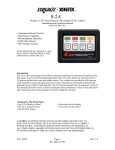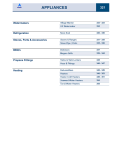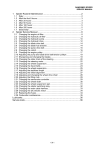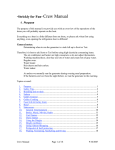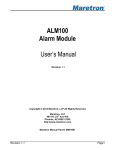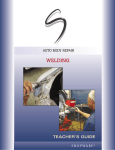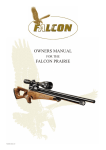Download Nova Kool CHAPTER 10 User's Manual
Transcript
American Tug 34 Owner Experiences Chapter 10 Galley Refrigerator Manufacturer Nova Kool Manufacturing Inc. Website http://www.novakool.com/ Phone (604) 523-6515 (This is an International call from the US). FAX (604) 523-6674 Email: [email protected] [email protected] [email protected] Address 1578 Hartley Avenue Coquitlam, BC Canada V3K 7A1 The model and serial number is located on a silver sticker on the inside of the refrigerator on the left hand side. We have a model RFU8000 which is a 6.8 cubic foot fridge/freezer combo with the refrigerator on top and the freezer on the bottom. Defrosting The refrigerator needs to be defrosted when ¼ inch of ice forms on the cold plate which is located in the top of the refrigerator compartment. This ice tends to insulate the components, and prevent efficient cooling. In really warm weather we do this every week. If the fridge needs defrosting often, check the door seal and the latch. If the bottom corner has a small gap, adjust the latch receiver on the frame. Remove heavy objects from the door – it tends to distort this seal. Venting Tomco seem to have a blind spot about refrigerator venting: I guess it must be a Seattle cold-weather thing, as in hot climates the refrigerator on our boat was not been able to maintain the ideal 38-40deg F temperature. It was running closer to 50 deg, which was turning much of our food into science experiments…. When we called the helpful people at NovaKool, and told them it was an American Tug, they right away said “It needs more venting”. They’ve seen this issue before (both with American and Nordic Tugs !). NovaKool specifies a total of 120 square inches of ventilation for the type of fridge that we have (60 square inches at the top for venting out the hot air and 60 square inches at the bottom for letting in the cooler air). This is actually specified in the user’s manual on page 4. On my boat (hull #48) there is a narrow grill above and below the fridge for ventilation. This provides about 80 square inches in total Chapter 10 Galley Page 10-1 American Tug 34 Owner Experiences ventilation – 40 at the top and 40 at the bottom. To make matters worse, if you subtract the restriction from the grills (as the manual suggests), the actually ventilation is about half that. In addition, they recommended that the ventilation be towards the back rather than at the front, as it is in our installation. Tomco added now added more ventilation on more recent boats. I found that “HeartTug” hull#95 has narrow slots routed into the cabinetry below the microwave as well as a vent above the microwave. Later boats have a rectangular grill installed on the side of the refrigerator cabinet, by the steps. NovaKool suggested that we perform the following test to see if venting was the cause of our poor performance. • Get a fridge thermometer so that you can see exactly how it’s doing. (We keep one in the fridge as well as the freezer.) • Make sure the fridge has been recently defrosted so that there is no heavy frost build-up on the cold plate at the top of the fridge. (We defrost the fridge weekly in warm weather and every 2-3 weeks in cooler weather, depending on the frost build-up.) The NovaKool rep mentioned that if you consistently have a heavy frost build-up, then the problem may be the seal around the door. • Remove the fridge from the cabinet, set the thermostat to #4 and leave it out in the salon area overnight. (It generally takes about 8-12 hours to see a noticeable difference in internal fridge temp when you make any changes, such as changes to ventilation, defrosting, or changes to the thermostat). • If the fridge cools down to an appropriate temperature, then the problem is ventilation. If not, then it’s time to start looking for a NovaKool technician. Removal 1. Remove the quarter-round trim strip on the left hand side of the fridge - closest to the steps. (8 long screws) 2. Remove the cabinet door closest to the freezer. This makes it easier to get the fridge out without dinging the door in the process. (4 screws in the 2 hinges). 3. Remove the 6 short screws holding the fridge in place. 4. Pull the fridge aft a short distance, then lift it up over the short wood base trim piece. Additional Ventilation Intake We purchased a ‘Seateak’ 9in x 16 in teak vent cover from West Marine to use for a new intake vent. We cut a hole in the side of the cabinet sized to fit the vent over, just above the top step, starting about one inch above the carpet and one inch back from the corner molding. This put the intake right next to the compressor, which is in the space between the fridge and the freezer. Chapter 10 Galley Page 10-2 American Tug 34 Owner Experiences Outlet As previously noted, later AT34s have factory-installed vent slots above the fridge (i.e. behind the microwave). They also have a grill in the middle of the countertop surface above the microwave. You will need to remove the microwave to see if you have this venting. The microwave is easy to remove, lift the front edge and pull it out. The Microwave is heavy (25lbs ++). A second person is needed to unplug it from the outlet once you’ve pulled it out. To reinstall the microwave, reverse the procedure: the front feet fit into ‘sockets’ in the woodwork to hold it in place. We did not have this venting, so we started searching around for a solution. We came across a vent with a collection box arrangement in West Marine. The collection box has two 3 inch holes to which we attached some air vent hose and ran them down to two 3 inch holes cut into the bottom of the microwave cabinet. This has the added advantage of allowing the hot air from the fridge to vent past the microwave and directly out into the cabin, behind the starboard pilot house seat. We like having the vent hole on the side rather than on top of the microwave cabinet, as we could imagine the problem of small things falling through the vent if it is on top of the cabinet. Chapter 10 Galley Page 10-3 American Tug 34 Owner Experiences We drilled two 3 inch diameter holes in the back of the microwave shelf as well as an exit vent in the back of the microwave area. This picture shows the microwave compartment, with the microwave removed and the two hoses leading up to the bottom of the collector box. Fans I installed a 3 inch diameter computer fan under one of the 3 inch holes to extract air. I wired this to the existing fan control connections on the control box. NovaKool representative told me that control unit is rated to switch up to 0.5amps (A) of fans. There is already a 6in unit installed at the back of the fridge that is rated at 0.28A. The 3inch fan that I added is 0.1A, so I’m comfortably below their limit. I noticed that the existing fan was installed on the starboard side of the fridge, set to blow air starboard to port across the compressor. Since we now had a big inlet vent on the port side of the fridge, I removed it and relocated it to the port side, just behind the new grill I installed, and reversed it to pull air IN. Parts Part Vent cover – microwave cabinet Collector Box Hose (we used 3 ft of hose in total) Vent cover – fridge cabinet Additional fan Manufacturer’s Part Number Attwood 1494A5 (Black) Attwood 1341-1 Shields 3 inch 116-4003000W Seateak 9” x 16” louvered vent cover Unknown - 3in computer fan from Radio Shack West Marine Number 1202050 (Catalog page #463 2260735 103812 Not in the West catalog. Not all stores stock these – you need to call the store near you to see if they stock them. --- Interior Light Richard Gray (AT34 #087 “Gray Dawn”) suggests: “If you open your refrigerator and the light inside is hot, it is not turning off when the door is shut. Just buy the small clear cabinet door bumpers at Lowes / Wal- Chapter 10 Galley Page 10-4 American Tug 34 Owner Experiences Mart /Home Depot and put one on the light switch to give you the extra 1/8 inch needed to turn off the light.” Door Thumb latches Some ATs have little thumb 'backup' latches on the refrigerator door, to secure it better in rough water. We did not have these, but NovaKool were happy to send us two, at no charge. How nice is that?? They arrived in short order and Marion (I think that is his name) even called a week later to ask if I had received the latches and if I had any questions or problems in installing them. The fridge and freezer door are designed to be reversible, for left-hand (as we have) or right-hand opening. These latches screw into the three already-drilled ‘extra’ holes for the hinges. The screws take a little effort to get them started, as they are self-tapping. Ice Maker This is an option on AT34s, and if fitted, is installed in place of the cabinet to the right of the stove. Manufacturer Sea Freeze of America Inc. Website http://www.seafreezeinc.com/ Phone: (360) 733-8282 FAX: (360) 738-2411 Email: [email protected] Address 1600 Kentucky St. Suite B6. Bellingham, WA 98229 We tend to only use our ice maker when we are in a marina plugged into shore power. It’s a hybrid AC/DC unit: the compressor is AC, while the control circuitry is DC. It therefore has a built-in inverter/charger, and is connected to both DC and AC circuit breakers. We prefer not to have the power drain of the ice maker when we are staying out on the hook. Whenever you turn off the ice maker and intend to leave it off for more than a day, be sure to leave the door open so that it can dry out. We made the mistake of shutting it off and leaving it off with the door closed for several months one time – this resulted in the internal rotor system corroding so much that the ice Chapter 10 Galley Page 10-5 American Tug 34 Owner Experiences maker would no longer function. The company sold us a new assembly (at cost) which fixed the problem, but they also recommended leaving the door slightly open when it is not in use so that the inside could dry out. Doug Lindal reported: “There were two problems, no AC operation and a whine on the DC side. The first issue was a real no-brainer: the icemaker is plugged into a separate GFI outlet under the sink and it has apparently been tripped since the boat was delivered! I had of course checked to make sure it was plugged in, but never suspected that it was on a separate GFI circuit. The DC problem with the icemaker turned out to be a stripped screw that caused a loose connection of the wire to the 20A circuit breaker on the panel. The unit was consequently only getting 7-8 amps instead of the 13 amps it needs to operate so it whined and shut down, which is a good thing as it could have burned out the compressor motor. “ Stove – Force 10 Contact info: Force 10 Marine Company 23080 Hamilton RD. Richmond, BC Canada, V6V 1C9 Phone (800)-663-8515 www.force10.com Email [email protected] We have a Force 10 propane 3-burner stove with and oven. The model number for our stove is 73351. There is a white sticker under the oven on the left hand side that has the model and serial numbers on it. Most west coast boats have propane, while most east coast boats have electric. Most boats have a stove with an oven, while some have just a cook top. These boats tend to have a combination convection/microwave rather than the standard microwave oven that most boats have. Propane Stove Components The propane stove option includes the following components: • Propane tank – A 20 pound aluminum propane tank which is installed in the cockpit locker on the starboard side of the boat. This locker is sealed from the boat interior, and has vents into the cockpit. • Regulator – Used to regulate the pressure coming from the tank to the stove • Pressure gauge from 0 – 300psi. Normal full tank pressure is around 120psi • Solenoid – An electric valve that is located after the regulator and before the gas line leading to the stove Chapter 10 Galley Page 10-6 American Tug 34 Owner Experiences • • • Xintex/Fireboy control unit – A control pad located by the door on the side of the galley cabinet. Propane sniffer – a small orange plastic device located under the galley counter used to identify propane gas if there is a leak. (Propane is heavier than air, so the sniffer is generally located low on a boat.) Force 10 stove Propane Control and Leak Detector The Xintex control unit is used to open and close the solenoid and also to monitor the propane sniffer. If the unit senses propane, it will sound and alarm. Its is powered from a distribution panel under the dash, that is fed through the ‘always-on’ circuit controlled by a 30A breaker under the pilothouse seat. http://fireboy-xintex.com/ Xintex Control Unit and Propane Sensor The Xintex/Fireboy S-2A we have can monitor two sensors, but only had one installed (the red thing in the photo above) under the galley drawers. We added a second one, under the stove itself, ordered from the Xintex website. It is a MS-2 Gasoline and Propane Sensor with 20' cable, $87.00 in 2004, and plugs right into the control unit. Testing To test the sensor, press the button below each sensor. It should sound the alarm which is silenced by pressing the alarm silence button. Periodically, we also carefully spray propane from a barbeque lighter on each sensor. Propane tanks are installed with a pressure gauge that after the regulator and before the shutoff solenoid. Periodically you should do the following pressure tests to ensure that there are no propane leaks: • • With the solenoid closed and the stove burners closed, check that the pressure gauge holds pressure. If it does not, there is a leak somewhere between the solenoid and the tank. Use soapy water over the short line and fittings to locate this leak. With the solenoid open and the stove burners closed, check that the pressure gauge holds pressure. If it does not, there is a leak somewhere between the Chapter 10 Galley Page 10-7 American Tug 34 Owner Experiences solenoid and the stove. This is much more difficult to track down – as the lines run behind the countertop on the starboard side of the boat. Check the fittings first, as they are usually the source of propane leaks. Safety Red Rag We always keep the valve closed on our propane tank unless we are using the stove. As a reminder that the valve is open, we keep a red rag draped over the top of the tank. When we open the valve, we take the rag and place it in a prominent position in the galley. If we look and see the rag in the galley, it’s a visual reminder that the valve is open. Propane – cleaning orifices The only problem we’ve had so far was with the oven. I noticed one day when I was trying to bake something that it was not coming up to temperature. When I called the folks at Force 10, they suggested that I needed to clean the oven orifice. You will need a 7mm wrench to remove the orifice – which is a bit of an unusual size. They sent me the following instructions: 1. Unscrew the oven burner bracket from the back of the stove. 2. Rotate the burner (#55) 180 degrees to gain access to the orifice. (We ended up removing this to get at the orifice) 3. Remove the orifice from the orifice holder with a 7mm wrench (#56 is the orifice and # 57 is the holder) 4. Clean out the orifice with forced air or with a cotton swab dipped in alcohol. Never use metal to clean the orifice Chapter 10 Galley Page 10-8 American Tug 34 Owner Experiences Electric Stove We don’t have the electric stove – so need info here… Chapter 10 Galley Page 10-9









